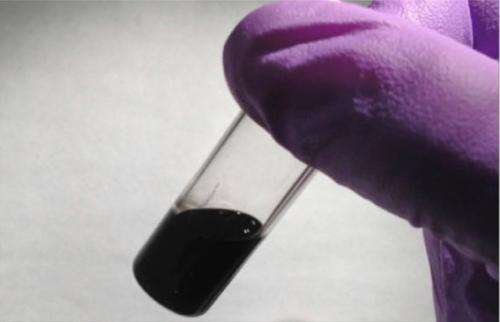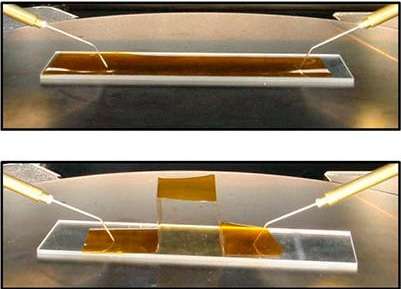April 24, 2013 feature
Inkjet-printed graphene electrodes may lead to low-cost, large-area, possibly foldable devices

(Phys.org) —Using an ink containing tiny graphene flakes, scientists have inkjet-printed graphene patterns that can be used for printing finely detailed, highly conductive electrodes. Although inkjet-printed graphene has been previously demonstrated, the graphene patterns printed in the new study are about 250 times more conductive than previous patterns. The printed graphene ink is also highly tolerant to bending stresses, with the ability to withstand folding with only a slight decrease in conductivity.
The researchers, Ethan B. Secor, et al., at Northwestern University in Evanston, Illinois, have published their study on inkjet-printing graphene patterns in a recent issue of The Journal of Physical Chemistry Letters.
As the researchers explain, inkjet printing is an attractive method for printing electronic components because it is low-cost, can print large areas, and can print on flexible substrates. Researchers have previously used inkjet printing to fabricate a variety of components such as transistors, solar cells, LEDs, and sensors. However, printing highly conductive electrodes is still a challenge because of the requirement for very fine resolution. Recently, researchers have turned to graphene due to its high conductivity, chemical stability, and intrinsic flexibility compared to other inks, hoping that graphene-based inks could be used for printing electrodes.
One of the most important steps in printing with graphene ink is obtaining a large amount of graphene. There are several methods for mass-producing graphene, but the one with advantages for inkjet printing is exfoliation—or the breaking apart—of other materials such as graphite or reduced graphene oxide (RGO) to produce graphene flakes. Previous studies have demonstrated inkjet printing of exfoliated RGO flakes for electrodes, sensors, and other applications. However, the electrical properties of RGO flakes, which contain carbon, oxygen, and hydrogen atoms, are inferior to the properties of pristine graphene flakes, which contain only carbon atoms.
The methods currently used to produce pristine graphene through exfoliation have encountered a few challenges. The process typically requires solvents and surfactants that leave residues on the graphene, which decreases its conductivity. Another problem is that, while small graphene flakes are necessary for stable printing, they increase the number of flake-to-flake junctions, which also decreases conductivity.

In the new study, the scientists developed a new approach that overcomes these problems. The new room-temperature process uses ethanol as a solvent and ethyl cellulose as a stabilizing polymer, neither of which leaves a residue. This method produces high yields of a black powder with a graphene content of 15%, which is higher than most previous methods. The graphene flakes in the powder have thicknesses of about 2 nm and areas of about 50 x 50 nm2. Although such a small flake size results in numerous flake-to-flake junctions, the ethyl cellulose stabilizing polymer reduces the resistance between flakes better than other surfactants.
The researchers then dispersed the black powder into a solvent to create a fluid ink that can be used for printing. They demonstrated inkjet printing with the graphene-based ink and found that the ink's excellent morphology and conductivity enabled printing of precise patterns suitable for printing electrodes. The researchers could also print multiple layers of ink while maintaining uniform patterns, with each layer adding about 14 nm to the thickness.
The researchers assessed the printed ink's mechanical properties by printing lines on flexible polyimide substrates. They found that the ink's conductivity remained virtually unchanged even at high bending radiuses of less than 1 mm, even though the substrate began to crack. Even when the researchers folded a substrate with printed features, the ink showed only a 5% decrease in conductivity that can likely be attributed to substrate cracking rather than damage to the ink itself. The mechanical tests suggest that graphene inks may be used to create foldable electronic devices in the future.
"Essentially all electronic devices and circuits required high-conductivity and high-resolution electrical contacts and interconnects," coauthor Mark Hersam, a professor of Materials Science and Engineering at Northwestern University, told Phys.org. "Therefore, our graphene inks have the potential to impact a wide range of applications, especially printed electronics, flexible electronics, and foldable electronics. Example downstream applications for these types of electronic devices include smartphones, tablets, flat panel displays, and photovoltaics."
In the future, the researchers plan to work on applying the new graphene ink to these kinds of applications.
"Thus far, we have achieved the graphen ink development and characterization," Hersam said. "On the other hand, our future research will focus on integrating our printed graphene inks into fully fabricated electronic devices and circuits including the downstream applications listed above. In this manner, we can fully exploit our fundamental research advances for real-world technology."
More information: Ethan B. Secor, et al. "Inkjet Printing of High Conductivity, Flexible Graphene Patterns." The Journal of Physical Chemistry Letters. DOI: 10.1021/jz400644c
Journal information: Journal of Physical Chemistry Letters
Copyright 2013 Phys.org
All rights reserved. This material may not be published, broadcast, rewritten or redistributed in whole or part without the express written permission of Phys.org.



















